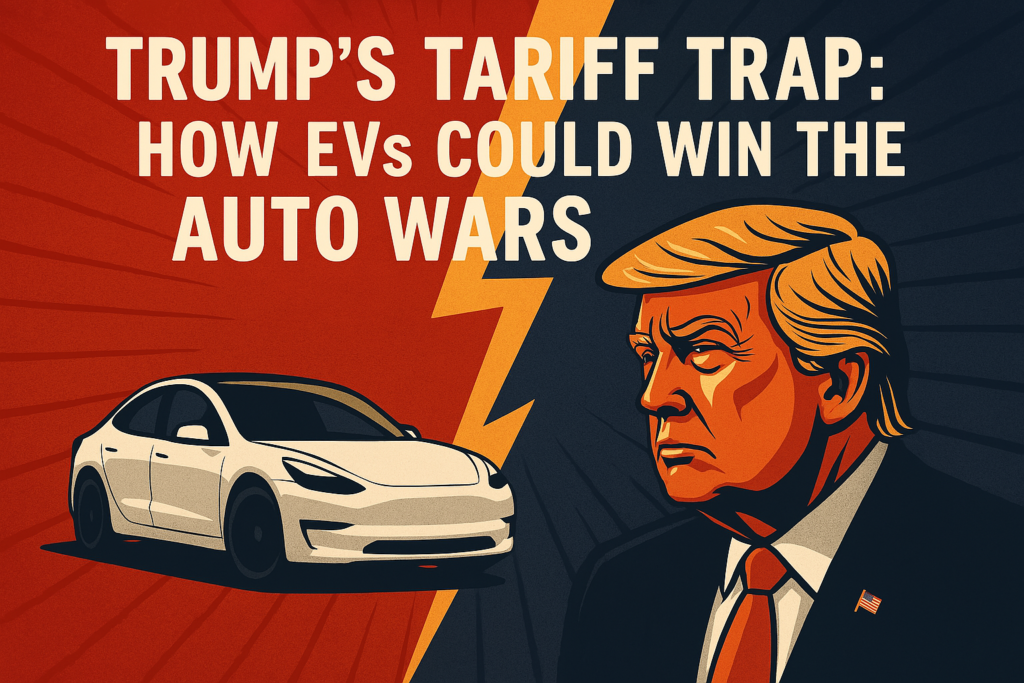Donald Trump’s proposed 25% tariffs on imported cars and auto parts are framed as a lifeline for American automakers. But the unintended consequences could turbocharge electric vehicle (EV) adoption, reshaping the market in ways that leave gas-powered cars in the dust. Trump’s tariffs are a wrecking ball—but instead of crushing imports, they might demolish ICE car sales.
1. Tariffs Inflate Prices for Gas Cars and Imported EVs
The 25% tariff could add $5,000–$10,000 to the sticker price of imported vehicles, including gas-powered cars and foreign-made EVs like the Volkswagen ID.4 or Hyundai Ioniq 5. This price hike hits traditional automakers reliant on global supply chains hardest. For example, a Toyota Camry assembled in Kentucky still uses 40% imported parts, which could raise costs for U.S.-made ICE vehicles, too. Suddenly, EVs built domestically—with fewer tariff-affected components—gain a pricing edge.
2. Tesla’s Localized Supply Chain Turns It Into a Bargain Brand
Tesla’s vertically integrated U.S. factories (think Texas Gigafactory) insulate it from tariffs. While rivals hike prices, Tesla continues its price-cut streak—the Model 3 now starts at $38,990, down 20% since 2022. If tariffs take effect, Tesla could undercut competitors further, morphing from a luxury marque into the “everyday EV.” This shift mirrors Samsung’s strategy in the 1990s: leveraging protectionist policies to dominate market share while foreign rivals falter.
Yes, Tesla CEO Elon Musk announced on March 11, 2025, that the company plans to double its vehicle production in the United States within the next two years. Currently, Tesla’s U.S. production capacity stands at approximately 1 million vehicles annually, with the Fremont Factory capable of producing over 650,000 vehicles per year and Gigafactory Texas around 375,000 vehicles per year (Teslarati, WSJ, Electrive).
To achieve this ambitious goal, Tesla intends to significantly increase output, particularly at Gigafactory Texas, by ramping up production of new models such as the Cybercab. Musk has previously indicated that Tesla aims to produce at least 2 million Cybercabs annually, with production expected to commence in 2026 (Electrek, Teslarati, Wikipedia).
This expansion aligns with Tesla’s broader strategy to enhance manufacturing capabilities and meet the growing demand for electric vehicles in the United States. But beyond just production scaling, Musk appears to be banking on a shift from car ownership to TaaS (Transport as a Service). With tariffs driving up vehicle costs across the board, Tesla’s robotaxi fleet could step in as the affordable alternative to car ownership, especially in urban centers. If Cybercab production reaches Musk’s 2 million-unit annual target, Tesla could disrupt traditional ride-hailing services and make TaaS a mainstream option in the U.S.
Now, let’s be clear—I’m no fan of Musk. The more unhinged he becomes in the political and policy realm, the more it seems like he’s steering Tesla down the same ideological path that Hitler took Volkswagen—tying a corporate identity to an increasingly erratic and authoritarian vision. But facts are facts, and Musk’s strategy is undeniably positioned to capitalize on these tariffs, whether intentional or not.
3. Legacy Automakers Face a “Go EV or Die” Ultimatum
GM and Ford already lose ~$6000 per EV sold. But tariffs on imported parts (e.g., Mexican-built engines or Chinese batteries) could make gas cars even costlier to produce. To avoid double jeopardy—rising ICE costs and EV losses—legacy automakers may fast-track domestic EV production. GM’s Ultium platform and Ford’s BlueOval City are steps in this direction, but tariffs could force a $50 billion industry to sprint toward electrification.
Ford and GM also rely heavily on truck sales, and the transition to EV trucks remains a battle. The F-150 Lightning and Chevy Silverado EV have struggled with pricing and production costs, making them less attractive compared to their cheaper gas counterparts. Meanwhile, Tesla’s Cybertruck—for all its controversy—is attempting to redefine the market. Whether Tesla can deliver a truck that truly competes on towing capacity, durability, and range remains to be seen, but if traditional automakers fail to adapt, they risk losing their most profitable segment.
4. Foreign EV Makers Rush to Build U.S. Factories
Chinese automakers like BYD (which sells EVs for $12,000 in China) and Europe’s Volvo are already scouting U.S. factory sites to bypass tariffs. BYD’s Mexico plant, announced in 2024, positions it to enter the U.S. market tariff-free under USMCA rules. Similarly, VW’s $2 billion Tennessee EV hub could expand. This “localization wave” would flood the market with affordable EVs, mirroring Japan’s 1980s U.S. factory boom to skirt import restrictions.
5. Economics Tilt the Scale Toward EVs
With gas cars pricier upfront, EVs’ lower lifetime costs (30% cheaper to maintain, per DOE) become decisive. For the average buyer, a $40,000 Tesla with $500 annual charging costs could compete with a $35,000 ICE car that requires $1,200/year in gas. Add state/federal EV incentives (up to $7,500 tax credits), and the math gets even clearer.
6. Could Tariffs Backfire? Counterarguments to Consider
Critics argue that tariffs could backfire if U.S. automakers can’t scale EV production fast enough, leaving consumers with fewer affordable options. Others note that truck-dependent buyers—key to Ford’s profits—may resist EVs even with price parity.
There’s also the question of policy timelines—Trump’s tariffs will take effect on April 3, 2025, but foreign automakers’ localization efforts (e.g., BYD’s Mexico plant) may take until 2027 or later to fully ramp up production.
Still, history suggests companies that wait too long get left behind—just ask Kodak or Nokia. Automakers that embrace the shift early could dominate the next phase of the industry.
Conclusion: The Battle Lines Are Drawn in the Auto Wars
Trump’s tariffs aim to shield legacy automakers but may instead catalyze their existential crisis. By making gas cars costlier and foreign EVs untenable, the policy could:
- Boost Tesla and U.S.-made EVs as default affordable options.
- Force foreign automakers to “go local,” increasing EV supply.
- Push consumers toward EVs as cost-competitiveness widens.
- Accelerate the shift from car ownership to TaaS, giving Tesla a lead in autonomous mobility.
The Auto Wars are no longer a battle between gas and electric—it’s a war of survival for legacy automakers, a race for market dominance by disruptors, and a fight for relevance in a changing world. The battlefield is set, and the winners will be those who adapt fastest and smartest.


